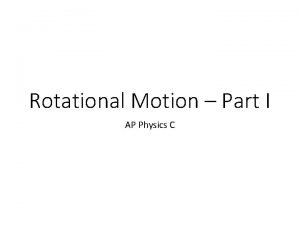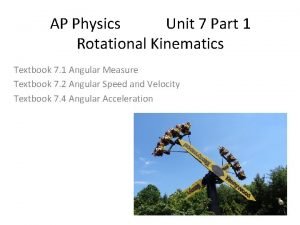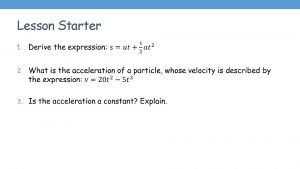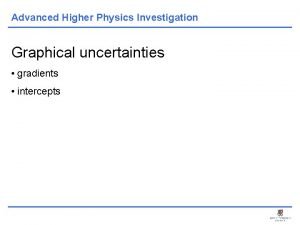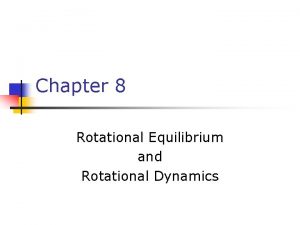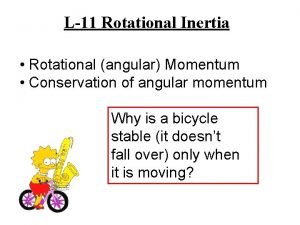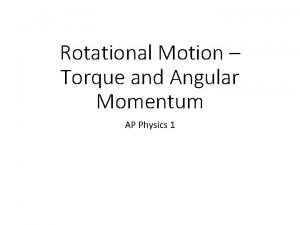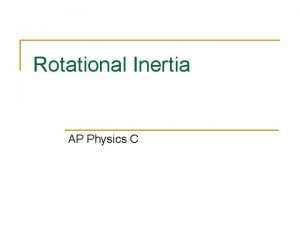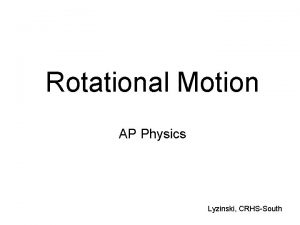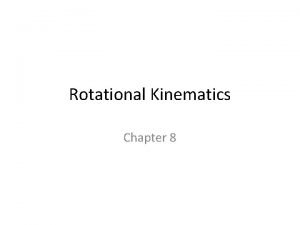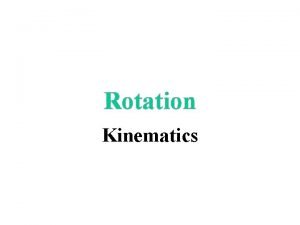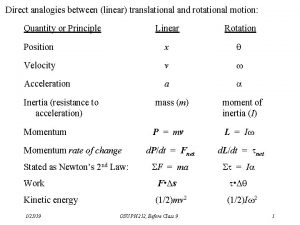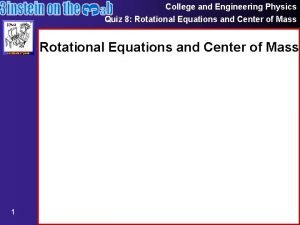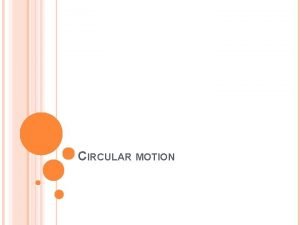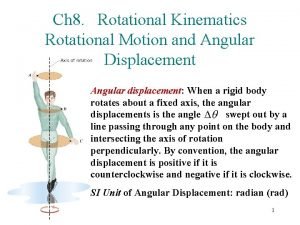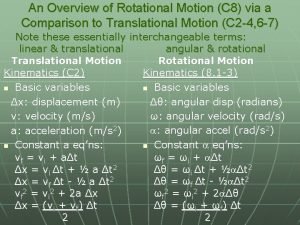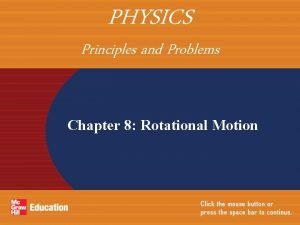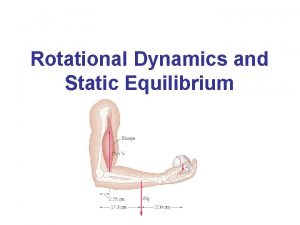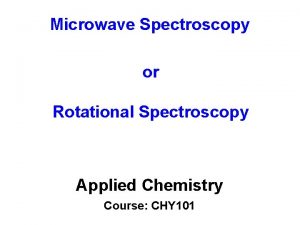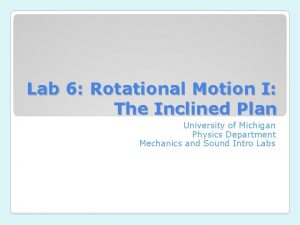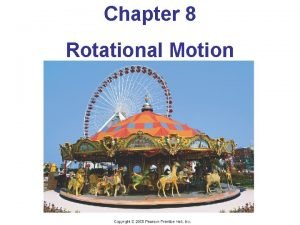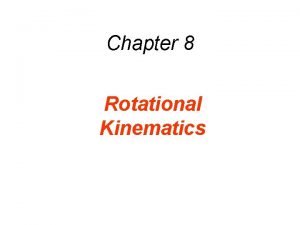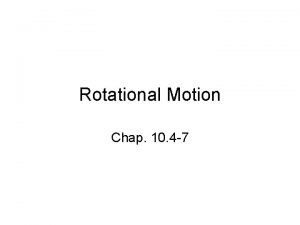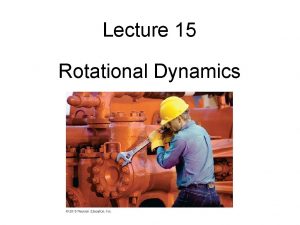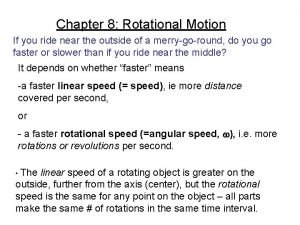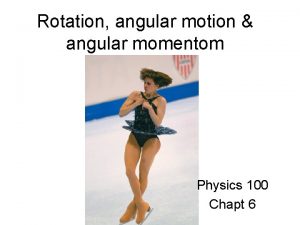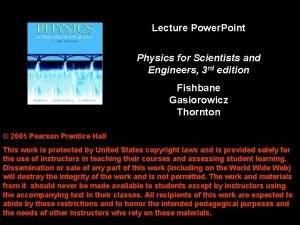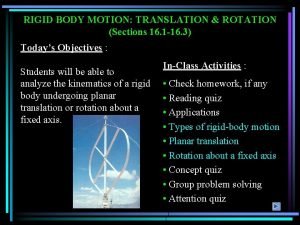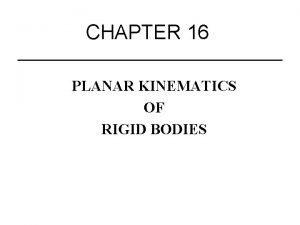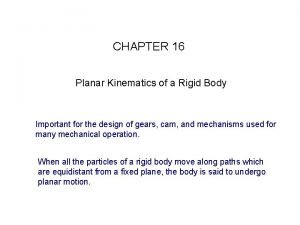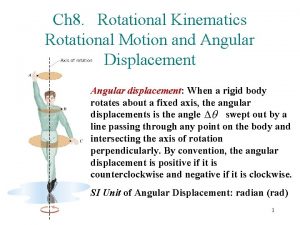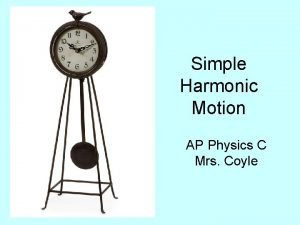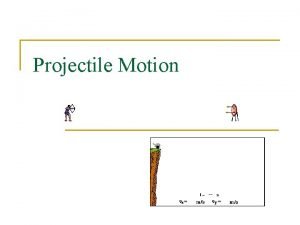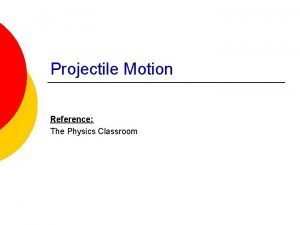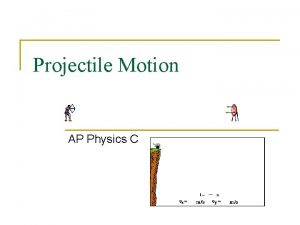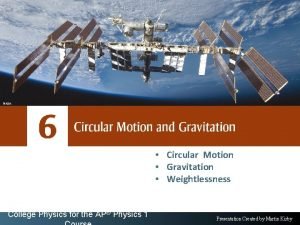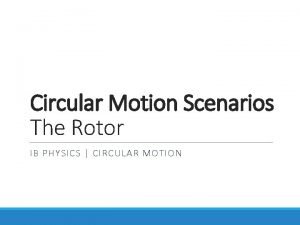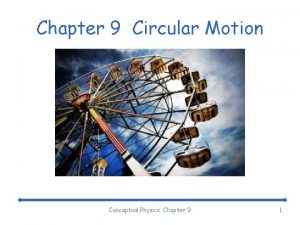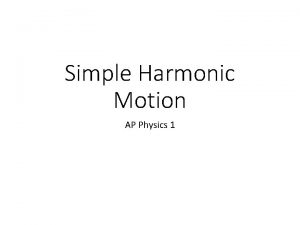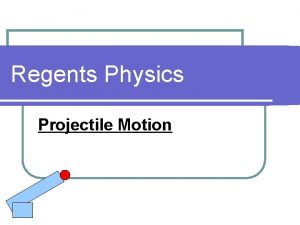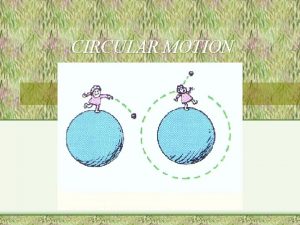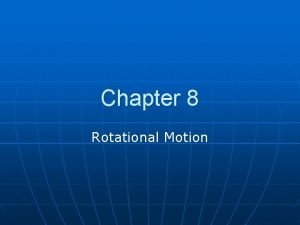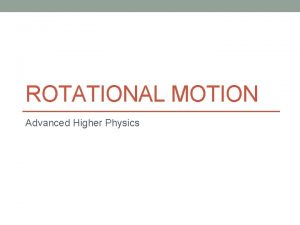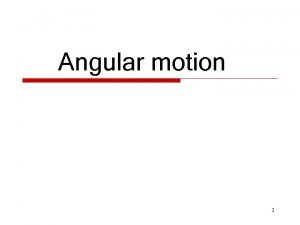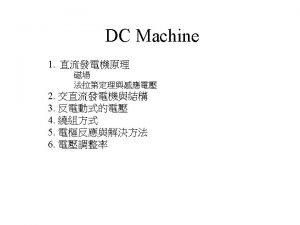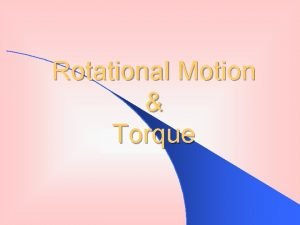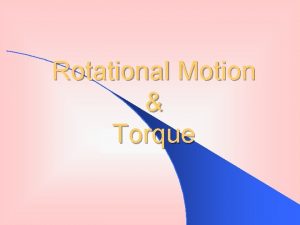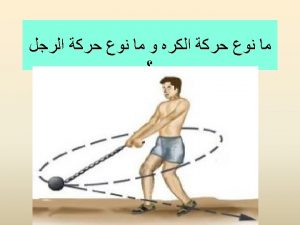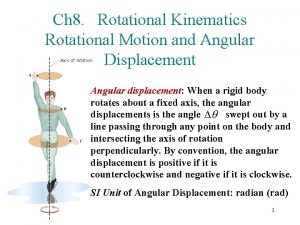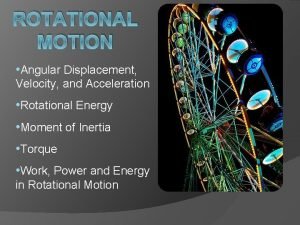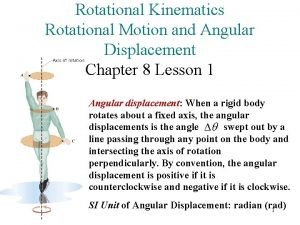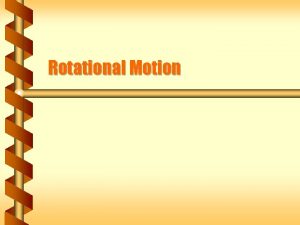Lesson Starter ROTATIONAL MOTION Advanced Higher Physics Angular





























































































- Slides: 93

Lesson Starter •

ROTATIONAL MOTION Advanced Higher Physics

Angular displacement and radians • Firstly we will look at angular displacement, which replaces the linear displacement we are used to dealing with. Imagine a disc spinning about a central axis. • We can draw a reference line along the radius of the disc. • The angular displacement is the angle through which this line (the radius) has swept in time.

Angular displacement and radians •

Angular displacement and radians • 360° is equivalent to 2π rad, and this relationship can be used to convert from radians to degrees, and vice versa. • It is useful to remember that π rad is equivalent to 180° and π/2 rad is equivalent to 90°. • For the sake of neatness and clarity, it is common to leave an angle as a multiple of π rather than as a decimal, so the equivalent of 30° is usually expressed as π/6 rad rather than 0. 524 rad.

Changing Degrees to Radians • Not on formula sheet

Copy into notes jotter Angular displacement and Radians • The angular displacement is given the symbol θ, and is measured in radians (rad). • The angular displacement is the angle through which the radius has swept in time.

Angular velocity and acceleration • Copy into notes jotter:

Example Copy into notes jotter: • It takes the Moon 27. 3 days to complete one orbit of the Earth. Assuming the Moon travels in a circular orbit at constant angular velocity, what is the angular velocity of the Moon?

Answer •

Orbits of the planets Fill in the gaps for the following planets:

Copy into notes jotter: Revolutions per minute to Radians per second • Not given in formula sheet

Tutorial 2. 0 • Questions 1 -4

Radian Quiz

Radians quiz

Periodic time and angular velocity • 2π 0 3π/2 π

Copy into notes jotter: Angular velocity, period and frequency • Where: ω = angular velocity (rad s-1) T = period of rotation (s)

Copy into notes jotter: Angular velocity, period and frequency • Where: ω = angular velocity (rad s-1) f = frequency of rotation (Hz)

Mandatory Course Content Covered

Angular Acceleration •

Copy into notes jotter: Angular Acceleration • Where: ω = angular velocity (rad s-1) α= angular acceleration (rad s-2) t = time (s)

Kinematic relationships for angular motion •

Kinematic relationships for angular motion •

Kinematic relationships for angular motion •

Copy into notes jotter: Linear vs Rotational

Example 1 An electric fan has blades that rotate with angular velocity 80 rad s -1. When the fan is switched off, the blades come to rest after 12 s. What is the angular deceleration of the fan blades?

Example 1 Answer We follow the same procedure as we used to solve problems in linear motion - list the data and select the appropriate kinematic relationship. Here we are told ω 0 = 80 rad s-1 -1 ω= 0 rad s t = 12 s α= ?

Example 2 Copy into notes jotter: A wheel is rotating at 35 rad s-1. It undergoes a constant angular deceleration. After 9. 5 seconds, the wheel has turned though an angle of 280 radians. What is the angular deceleration?

Example 2 Answer • Copy into notes jotter:

Example 3 An ice skater spins with an angular velocity of 15 rad s -1. She decelerates to rest over a short period of time. Her angular displacement during this time is 14. 1 rad. Determine the time during which the ice skater decelerates.

Example 3 Answer •

Lesson Starter 1. A disk start from rest and accelerates for 2. 5 s. After 2. 5 s the disk is rotating at 300 rpm. Calculate its angular acceleration. 2. Calculate the angular displacement of the disk.

Mandatory Content Covered

Lesson Starter 22/06/17

Tangential speed angular velocity •

Tangential speed angular velocity •

Tangential Speed angular velocity • There is an important difference between v and ω - that two objects with the same angular velocity can be moving with different tangential speeds.

Tangential Speed angular velocity • This difference in tangential speeds is emphasised in the diagram below:

Tangential Speed angular velocity •

Copy into notes jotter: Tangential speed angular velocity •

Example 1 Copy into notes jotter: A turntable of radius 0. 30 m is rotating at constant angular velocity 1. 5 rad s-1. Compare the tangential speeds of a point on the circumference of the turntable and a point midway between the centre and the circumference.

Example 1 Answer • Copy into notes jotter:

Tangential Acceleration •

Copy into notes jotter: Tangential Acceleration •

Mandatory content covered

Experiment • Find the following for your own objects in circular motion: 1. Radius of string 2. Time taken for 10 rotations 3. Angular displacement 4. Tangential velocity 5. Angular velocity • Try with different radii

Centripetal Acceleration Consider an object moving in a circle of radius r with constant angular velocity ω. We know that at any point on the circle, the object will have tangential velocity v=rω. The object moves through an angle Δθ in time Δt.

Centripetal Acceleration • The change in velocity Δv is equal to vb-va. We can use a 'nose-to-tail' vector diagram to determine Δv , as shown below. Both and have magnitude v, so the vector XY represents vb and vector YZ represents -va.

Centripetal Acceleration • In the limit where Δt is small, Δθ tends to zero. In this case the angle ZXY tends to 90°, and the vector Δv is perpendicular to the velocity, so Δv points towards the centre of the circle. • The velocity change, and hence the acceleration, is directed towards the centre of the circle. • Centripetal acceleration has the symbol a r since it acts towards the centre of the circle.

Centripetal Acceleration •

Centripetal Acceleration • The centripetal acceleration is always directed towards the centre of the circle, and it must not be confused with the tangential acceleration, which occurs when an orbiting object changes its tangential speed. • The centripetal acceleration occurs whenever an object is moving in a circular path, even if its tangential speed is constant. (can also be referred to as “radial acceleration”)

Copy into notes jotter: Centripetal Acceleration •

Example 1 • Find the centripetal acceleration of an object moving in a circular path of radius 1. 20 m with constant tangential speed of 4. 00 m s -1.

Answer •

Example 2 Copy into notes jotter: A model aeroplane on a rope 10 m long is circling with angular velocity 1. 2 rad s-1. If this speed is increased to 2. 0 rad s-1 over a 5. 0 s period, calculate 1. the angular acceleration; 2. the tangential acceleration; 3. the centripetal acceleration at these two velocities.

Answer • Copy into notes jotter:

Answer • Copy into notes jotter:

Answer • Copy into notes jotter:

Mandatory Content Covered

Centripetal Force •

Centripetal Force •

Centripetal Force • Copy into notes jotter:

Example 1 Copy into notes jotter: Compare the centripetal forces required for a 2. 0 kg mass moving in a circle of radius 40 cm if the velocity is: 1. 3. 0 m s-1; 2. 6. 0 m s-1.

Answer • Copy into notes jotter:

Mandatory Content Covered

Do you remember? •

Object moving in a horizontal circle •

Vertical Motion • Let us now consider the same object being whirled in a vertical circle. The diagram below shows the object at three points on the circle, with the forces acting at each point.

Vertical Motion •

Vertical Motion •

Vertical Motion •

Example • A man has tied a 1. 2 kg mass to a piece of rope 0. 80 m long, which he is twirling round in a vertical circle, so that the rope remains taut. He then starts to slow down the speed of the mass. • At what point of the circle is the rope likely to go slack? • What is the speed (in m s-1) at which the rope goes slack?

Answer •

Quiz

Quiz

Applications • When a person rides on a rollercoaster that follows a loop the loop track, they often feel very "light" at the top of the loop. Their weight does not change, it is the normal reaction force applied to them by the seat which alters. It is this which causes the strange sensation. • Assume the rollercoaster is moving at a constant speed, then the centripetal force required to keep them moving in a circle will also be constant. However, when they are at the top of the loop, the centripetal force is provided by both their weight and the normal reaction force. So the normal reaction force is very small and the person feels "light".

Rollercoaster

Rollercoaster

Conical Pendulum • The next situation we will study is the conical pendulum - a pendulum of length whose bob moves in a circle of radius at a constant height. The diagram shows such a pendulum, with a free-body diagram of all the forces acting on the bob.

Conical Pendulum •

Conical Pendulum •

Conical Pendulum •

Example • Consider a conical pendulum of length 1. 0 m. Compare the angle the string makes with the vertical when the pendulum completes exactly 1 revolution and 2 revolutions per second (ω = 2π rad s-1 and ω =4π rads-1).

Answer

Answer

Cars cornering • When a car takes a corner it is the frictional force between the car tyres and the road that provides the centripetal force. • If there is insufficient friction, the car will skid.

Cars Cornering •

Banked tracks • When a car is on a banked track, it can still successfully take a corner when there is no frictional force present. • Banked tracks are set at an angle, so the horizontal component of the normal reaction force provide the required centripetal force. The vertical component of the normal reaction force balances the weight.

Banked Tracks •

Funfair rides • One funfair ride which spins on its axis and then the floor drops gives people the sensation they are “stuck” to the wall. • What happens is the drum wall is exerting a normal reaction force, which provides the centripetal force to keep them moving in a circular path. • They do not fall because the friction acting upwards balances their weight.

Mandatory Content covered Mandatory Key Area Examples of key area

Quiz

Quiz
 Ap physics rotational motion
Ap physics rotational motion Ap physics c rotational motion
Ap physics c rotational motion Ap physics 1 unit 7
Ap physics 1 unit 7 Advanced higher physics data sheet
Advanced higher physics data sheet Higher physics uncertainties
Higher physics uncertainties Line of best fit in physics
Line of best fit in physics Torque free body diagram
Torque free body diagram Rotational equilibrium
Rotational equilibrium Higher physics equations of motion
Higher physics equations of motion Angular velocity and inertia
Angular velocity and inertia Angular momentum theorem
Angular momentum theorem Angular advanced topics
Angular advanced topics Advanced topics in angular
Advanced topics in angular Rotational kinetic energy ap physics 1
Rotational kinetic energy ap physics 1 10/7
10/7 Tangential speed
Tangential speed 4 linear motion equations
4 linear motion equations Rotation kinematic equations
Rotation kinematic equations Rotational and linear motion analogies
Rotational and linear motion analogies Physics equations quiz
Physics equations quiz Circular motion formula
Circular motion formula Symbol for angular displacement
Symbol for angular displacement Translational vs rotational motion
Translational vs rotational motion Difference between rotational and irrotational motion
Difference between rotational and irrotational motion Chapter 8: rotational motion study guide answer key
Chapter 8: rotational motion study guide answer key Rotational dynamics and static equilibrium
Rotational dynamics and static equilibrium Microwave spectroscopy
Microwave spectroscopy Rotational motion lab
Rotational motion lab Rotational motion
Rotational motion An old phonograph record revolves at 45 rpm
An old phonograph record revolves at 45 rpm Rotational motion
Rotational motion Torque rotational motion
Torque rotational motion Rigid body rotation formula
Rigid body rotation formula Conservation of angular momentum
Conservation of angular momentum Rotational motion chemistry
Rotational motion chemistry Chapter 8 rotational motion
Chapter 8 rotational motion Lesson starter
Lesson starter Understanding standards advanced higher pe
Understanding standards advanced higher pe Sqa advanced higher geography understanding standards
Sqa advanced higher geography understanding standards Sqa art and design understanding standards
Sqa art and design understanding standards Sqa understanding standards advanced higher computing
Sqa understanding standards advanced higher computing Advanced higher mathematics of mechanics
Advanced higher mathematics of mechanics Advanced higher graphic communication
Advanced higher graphic communication Advanced higher drama dissertation ideas
Advanced higher drama dissertation ideas Advanced higher biology unit 1
Advanced higher biology unit 1 Higher music concepts
Higher music concepts Understanding standards advanced higher english
Understanding standards advanced higher english Understanding standards advanced higher geography
Understanding standards advanced higher geography Advanced higher modern studies understanding standards
Advanced higher modern studies understanding standards Higher biology extended response
Higher biology extended response Higher history course specification
Higher history course specification Advanced higher english dissertation word limit
Advanced higher english dissertation word limit Higher english techniques
Higher english techniques Understanding standards advanced higher english
Understanding standards advanced higher english Sqa higher english understanding standards
Sqa higher english understanding standards Unit 3 higher biology questions
Unit 3 higher biology questions Advanced higher textual analysis
Advanced higher textual analysis Higher modern studies 12 mark essay examples
Higher modern studies 12 mark essay examples Advanced higher art
Advanced higher art Higher biology unit 3 questions and answers
Higher biology unit 3 questions and answers Sex determination in drosophilla
Sex determination in drosophilla Advanced higher biology
Advanced higher biology Right hand rule physics angular momentum
Right hand rule physics angular momentum Torque right hand rule
Torque right hand rule Curvilinear translation
Curvilinear translation Biomechanical principles pdhpe
Biomechanical principles pdhpe General plane motion
General plane motion Planar kinematics of a rigid body
Planar kinematics of a rigid body Angular motion equations
Angular motion equations Angular motion kinesiology
Angular motion kinesiology Quantity of angular motion possessed by a body
Quantity of angular motion possessed by a body Lesson 4 gravity and motion lesson review
Lesson 4 gravity and motion lesson review Fysix
Fysix Hubble's constant higher physics
Hubble's constant higher physics Mythbusters relative velocity
Mythbusters relative velocity Higher physics projectiles
Higher physics projectiles Why does it happen
Why does it happen University physics with modern physics fifteenth edition
University physics with modern physics fifteenth edition Physics hl ia examples
Physics hl ia examples Harmonic motion formula physics
Harmonic motion formula physics Projectile motion on inclined plane
Projectile motion on inclined plane Physics classroom projectile motion
Physics classroom projectile motion Formula for time of flight in projectile motion
Formula for time of flight in projectile motion Ap physics
Ap physics Projectile motion formula
Projectile motion formula Martin kirby physics
Martin kirby physics Igcse physics edexcel
Igcse physics edexcel Ib physics circular motion
Ib physics circular motion Circular motion conceptual physics
Circular motion conceptual physics Ap physics 1 simple harmonic motion
Ap physics 1 simple harmonic motion Projectile motion regents questions
Projectile motion regents questions A projectile has a single force that acts upon it
A projectile has a single force that acts upon it Final horizontal velocity
Final horizontal velocity Waves physics notes pdf download
Waves physics notes pdf download
